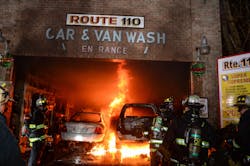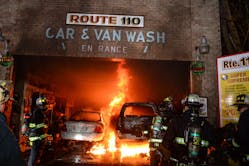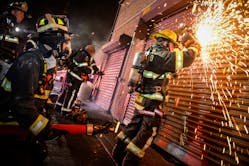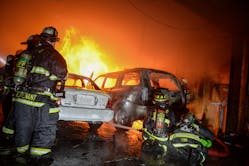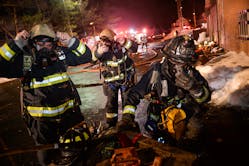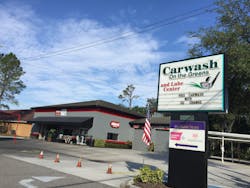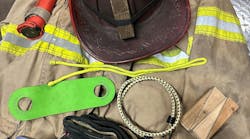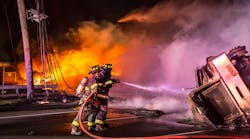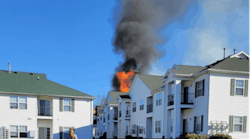Operating in many towns across the country, car wash establishments are a part of the fabric of “Main Street America.” Although a response to a fire at a car wash is an infrequent occurrence, most firefighters have likely patronized these businesses, resulting in a high degree of familiarity.
However, it is also likely that firefighters have never considered, discussed or trained on the unique features, design considerations or strategies and tactics to employ at this occupancy type. This article aims to bridge this procedural gap through a review of the strategies and tactics employed at a successful car wash fire.
Route 110 Car & Van Wash incident
On Jan. 10, 2018, at 6:41 p.m., members of the East Farmingdale, NY. Volunteer Fire Department (EFFD) were activated for a reported structural fire at the Route 110 Car & Van Wash. Upon arrival of the first units, smoke was observed pushing from the structure and the alarm was quickly upgraded to a working fire. Upon upgrade, additional fire units were dispatched including an engine, ladder, ambulance and rapid-intervention team (RIT) from adjoining fire departments as part of the mutual-aid plan.
With the business closed for the day, the arriving crews quickly forced entry through a roll-down gate and roll-down garage door, and discovered that there were multiple vehicles on fire inside the structure with extension to the contents.Many of these structures are very long and narrow with lightweight metal trusses running the short side of the building. Some, like this one, have a second floor or mezzanine over part of the first floor. This sometimes serves as a storage area or more likely an office area. This area was searched along with the other areas of the structure.
With the structure closed tight and smoke venting under pressure, members making entry along with the incident commander (IC) considered the ventilation profile of the structure and minimized and controlled ventilation openings until hoselines were charged and ready for operation. Understanding that cutting and removing commercial garage door roll-down gates creates additional ventilation points that will cause the fire to expand, each opening had a handline nearby. Once the entrances were opened, two hoselines quickly entered the structure and extinguished the fire.Because the car wash had been closed for the evening, the possibility that occupants would be in need of rescue was significantly reduced. Searches were quickly conducted with the primary goal of defining the fire area and determining fire extension. Thermal imaging cameras (TICs) were placed into operation to assist in the search and to monitor the heat condition above and the heat absorbed by the lightweight metal truss.
As is typical in this type of occupancy, the main area of the car wash was the automated conveyor belt-type area. This area was, as it often is, separated from the remainder of the occupancy by a glass wall and long hallway that allows customers to watch their cars being washed. This process is fully automated, and employees are rarely required to be inside the automated areas.
As is standard for all commercial occupancies in the area, the primary and backup hoselines were both 2½-inch lines. This is necessary at a commercial fire, especially when the fire area has not been fully determined and the need for greater reach is anticipated. The placement of two or more engines on hydrants is a sound practice any time of year and was accomplished early on. In cold climate areas where there is a chance of a frozen hydrant, this practice can minimize water delays that can lead to advanced fires. As it would turn out, two hydrants were needed, and there was no delay in obtaining a water supply since the engines were both in proper position before they were needed.
While it is EFFD policy not to cut lightweight metal truss roofs, a ladder crew was assigned to the roof early into the operation. Their mission was to examine the roof and determine the practicality of providing coordinated horizontal ventilation without cutting the roof. This ventilation could be skylights or vent pipes at roof level.
The long length of these structures calls for adequate sectors to be established and close coordination between the sectors to be followed. Following the establishment of Command, there were two sectors established, one at each end of the long structure with a chief officer assigned to each.Disciplined, brief and precise communications are a hallmark of a well-trained fire department. During this fire, a good stream of communications was sent and received. This included the status of the fire hydrants (frozen or operational), water supply (positive water), handline placement, coordination of ventilation with suppression, updates on the progress of hoseline advancement and fire extinguishment, status of searches, reports regarding fire extension, and control of the utilities. These communications benefit all on the fireground and help paint a visual picture for the IC.
Car washes use a large amount of electricity and have a large number of moving parts, potential pinch points, and tripping hazards within the automated area of the facility. The important task of removing power to the structure was complete early on and communicated to the IC.
Following extinguishment, the safety officer was tasked with ensuring that rehabilitation activities took place. This included hydration and the use of wipes to remove fireground contamination from the firefighters.
Additional considerations
Fires at car wash facilities present many unique features and hazards that will impact operations.Contents
At the scene, a young firefighter was overheard asking, “What is there to burn at a car wash?”
Do not be fooled or lulled into a false sense of security at car wash fires. There is plenty that can burn inside and quickly transition the area or structure to flashover. Two cars burning inside would be enough to flashover the entire area of the structure. Similarly, the large automated brushes and synthetic materials used in “brushless” applications that are part of the automated assembly line that scrub your car provide ample fuel to flashover and involve the entire structure.
Remember, the stored energy and heat release rates are enormous in today’s fires. Never underestimate this and prepare for the fire load found in all of today’s structural fires.
Ventilation
Occupancies that are closed have an increased probability of being a ventilation-limited fire upon arrival. Ensure the ventilation profile is evaluated prior to making entry.
Cutting and removing roll-down gates creates an additional ventilation point that will cause the fire to expand. Account for this with controlled forcible entry and coordinated ventilation with line placement and extinguishment.
Fire attack
Start every fire attack low to account for changing fire conditions and expect a hot and smoky fire with a variety of unusual layouts and hazards unique to this type of occupancy.
We must put water on the fire within the first 30–90 seconds following ventilation to control the fire with handlines, or the fire growth may accelerate to the point of overwhelming the initial handlines.
Building orientation and exposure identification
Initial exposure identification may be an issue. Often, for employees or others familiar with the layout of car wash facilities, the front of a car wash is considered the location where the cars enter and begin the cleaning process. This may not align with the layout of the building in relation to the front of the property (exposure 1 or the A side). Early communications confirming exposure identification will provide everyone with the same frame of reference and prevent confusion.
This common frame of reference is invaluable in the event of a mayday. When a mayday is called, firefighters often give the exposure they entered as a point of reference. An inaccurate reference can have disastrous results.
This is similar to the exposure challenges when operating at a church or other place of worship, where the front may be different depending on your location within or outside the structure. For example, when standing inside a church or attending a religious function, the front is often thought of as the area near the altar. This may not align with the front of the church as viewed by the IC.
TIC operations
Placing a TIC into operation to observe the heat condition above and the heat absorbed by the lightweight metal truss area can quickly lead the user to the point or area of origin by examining the thermal contrast on the metal truss.As conditions change from cooler to hotter back to cooler, the image viewed by the TIC will also change; this is known as changing thermal contrast. This changing thermal contrast may be an indication of fire being in close proximity and can be used to locate and define the fire area. However, due to a unique feature of car wash occupancies and a limitation of the TIC, firefighters may have a more difficult time locating the fire.
TICs have a difficult time measuring or “seeing” heat through clear glass and glass walls, both of which are commonplace in car wash occupancies. These glass walls typically separate the automated conveyor belt area from the remainder of the occupancy. This is how you are able to watch your car getting cleaned as it moves along the automated conveyor. These glass walls can obscure heat conditions present on the other side of the wall leaving a firefighter with an incomplete picture of the fire and heat conditions. If the glass wall is heated from the fire, this heat will be detected by the TIC. However, it is possible that a firefighter can observe a fire on the other side of the glass wall and not detect a change in thermal contrast on the TIC.
Building layout
A typical car wash layout consists of waiting areas for customers, separate rooms for auto detailing, and storage rooms for cleaning compounds.
Some car wash businesses may also offer oil changing and other light automotive services. These occupancies may have additional hazards, such as open pits in the floor and additional chemicals and oils stored.
Exterior Insulation Finish Systems
An Exterior Insulation Finish System (EIFS) covers exterior walls with a layered insulating and waterproofing finish. The aesthetic flexibility and insulating qualities of EIFS have made this type of building material desirable and commonplace on many structures, including some car wash occupancies. EIFS-covered structures are especially vulnerable when fires begin on the exterior of the building, such as a car fire, dumpster fire or similar fire close to the structure. An additional vulnerability occurs when an interior fire vents outward and exposes the exterior facade for a period of time.
A typical EFIS system consists of three layers. The first is a layer of insulation, followed by a reinforcing layer of mesh (usually fiberglass) and, lastly, a top coat usually of a cement-based polymer that is resistant to fire and makes it difficult to identify when complete.
The first and prime component is usually an expanded polystyrene foam (EPS) or similar material, essentially, Styrofoam. EIFS is considered combustible because of this layer and is typically one-quarter-inch to 8 inches thick. EPS will melt and flow when heated. Burning EPS will create high heat conditions, rapid flame spread and dense black smoke.
In conclusion
Although automated conveyor belt-style car wash businesses are common occupancies, fires in these occupancies are not common. While most firefighters would declare they are familiar with these businesses around town, it is likely that they may not have considered, discussed or trained on the unique features, design considerations or tactics to employ at this occupancy type. As such, it is important to incorporate these uncommon occupancies into training.
